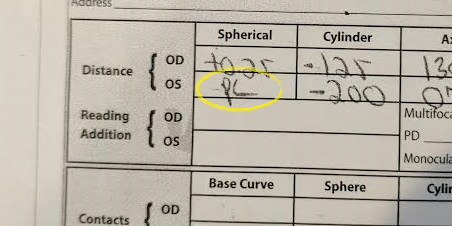Eyeglass Prescription Glossary / Abbreviations
Oculus Dexter (OD): is the Latin word for right eye.
Oculus Sinister (OS): is Latin for left eye.
OU (Oculus Uterque): is Latin for both eyes.
Power (SPH or PWR): This is the primary strength of your eyeglass prescription, and is indicated in increments of 0.25. If the field has the letters SPH, PL, PLANO, or 00, you should enter the 0.00 power as such. The sphere range of AC Lens can be between -20.00 and +20.00.
Plane (PL): This indicates that there is no spherical correction in this eye. A plane lens would not have any focusing power or correction.
Balance: This indicates that there is no vision correction in this eye. Non-prescription lenses are used when only one eye requires correction.
Cylinder (CYL): This indicates the amount of astigmatism, and is written in 0.25 increments. This correction is not available on all prescriptions, and some prescriptions have only one cylinder correction. This field may be left blank by your doctor if you do not have a correction for astigmatism in both or one eye, or it may be written ‘SPH’, ‘DS’, ‘Plano’, or ’00’. If this is the case, you do not have an astigmatism correction. It is possible for AC Lens to produce lenses for prescriptions in the range of -5.00 to +5.00. Positive (+) cylinder values will be converted to negative (-) cylinder values.
AX (AX or X): This is also part of the astigmatism correction and is written in increments of one (one). Without a cylinder, there should be no axis. The degree/angle will be expressed as a value between 1 and 180 since it is a degree or angle. If there is no cylinder, it is possible that the doctor will enter 0, but this will just indicate that there is no axis. AC Lens can manufacture lenses with ADD values between 0.25 and 3.00.
ADD: In addition to reading glasses and bifocal lenses, ADD is also a value commonly used for progressive lenses and bifocal lenses. With respect to the glasses you intend to order from AC Lens, this value indicates the amount of power that will be added to the distance Rx to create the reading-only Rx, or in the case of the bifocal progressive lenses you plan to purchase, it indicates the correction strength for the bottom half of the lens. Lenses with an ADD range of 0.25 to 3.00 can be created by AC Lens.
Prism, Base, or Base Curve: When both eyes are not aligned properly and a prism is needed to align them, it is used. The base refers to the rotation of the prism. A prism correction is composed of two parts. The first is the diopter strength (e.g. 2.0) and the second is the direction (e.g. BU). Currently, AC Lens eyeglasses do not offer these correction types. Prism corrections have four possible directions. These modes are BU – Base-Up, BD – Base-Down, BI – Base-In, and BO – Base-Out.
Pupillary Distance (PD): is the distance between the central points of both pupils of your eyes. Read more about how to measure your own PD on our Measuring Pupillary Distance (PD) page.
Segment Height or Seg Height (SH): The vertical measurement in millimeters between the bottom of a progressive lens and the beginning of the progressive addition on a lined bifocal lens, or to the top line. The segment height is not applicable to single vision lenses. The segment height can only be measured while you are wearing the glasses. You will need the frame to be able to measure the segment height.
“Near Vision Only” (NVO): is used to describe farsightedness. This is also referred to as nearsightedness.
DV or DVO: This is written when your doctor recommends distance-only glasses. Nearsightedness is also known as distance vision.
Astigmatism: An optical condition that can lead to blurry vision. It is corrected using both a cylinder and axis correction on the prescription.
Binocular: Describes the simultaneous use of both eyes simultaneously.
One-eyed: Refers to only one eye.
Progressive Additive Lenses (PAL): This is the ADD value that is specific to progressive lenses.
















